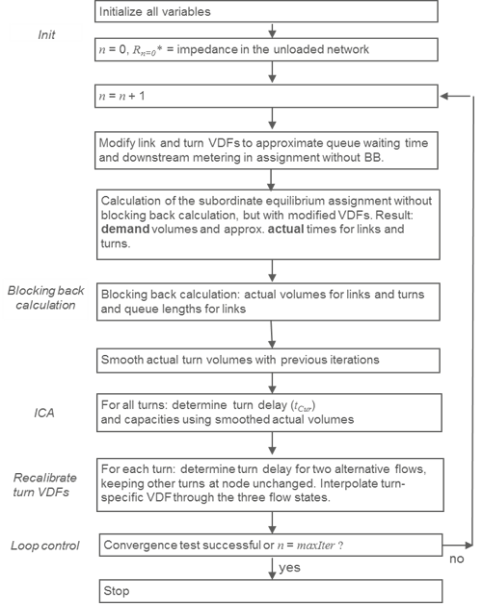The assignment with ICA is based on the iterative solution for the user optimum with volume-delay functions for all network objects. The distinctive feature is that the parameters of turn VD functions can be set by turn ("turn-specific) and might change during the calculation due to the adjustment of the ICA calculation results, as described with the fundamental principle (Fundamental principle).
- If the assignment with ICA is not based on existing assignment results, the parameters used in the VD function for turns and links are reset first. For turns, the input values are used that you have specified in the Procedure parameters dialog (Input tab). Depending on the control type used, additional signal times and geometric data are considered. The parameters reset for turn capacities, t0, and the VD functions A and B are used to perform the first subordinate assignment. Resetting the link attribute Effective capacity for assignment with ICA depends on the settings for blocking back calculation. If link capacities are taken into account, the value is initialized with Capacity PrT or the total of turn capacities in the link capacity model. If this is not the case, the initial value is infinite. If your assignment with ICA is based on existing assignment results, the parameters are available from the last assignment with ICA and there is no reset.
- First the subordinate assignment procedure is performed. Alternatively, you can use Equilibrium assignment Equilibrium assignment LUCE, or Equilibrium assignment Bi-conjugate Frank Wolfe. For nodes, for which ICA calculation has been activated, use turn-specific VD functions. In this case, no ICA calculations are carried out during the subordinate assignment procedure.
- The turn-specific VD functions used Illustration 104 (Used turn VD function) and the adaptation of link VD functions are described in different paragraphs (Adjusting the VD functions used).
- After completion of the subordinate assignment procedure, the blocking back model is applied. For calculation of the blocking back model, the turn capacities at nodes calculated with ICA are taken into account. Optionally, you may additionally use the capacities defined in the link capacity model. As a result of blocking back calculation, link impedances are adjusted, as congestion causes additional wait times on links, while downstream of the queues, travel times can be reduced due to less traffic flowing.
|
Notes: The blocking back model is not applied while the subordinate assignment procedure is performed. During finalization of the ICA assignment, the global parameters of the blocking back model are adjusted to the procedure parameters of ICA assignment, i.e. settings that differ are first ignored during ICA assignment and then overwritten. |
- Prior to the ICA calculation, the current values are determined for volume and impedance and also the parameters of the VDFs are recorded (according to the settings: in attribute files, as user-defined attributes and in the Goodness of PrT assignment with ICA list).
- Then, the turn volumes calculated in the recent iteration and in the current iteration are smoothed, i.e. the weighted mean is calculated.
- Using ICA, the program calculates turn impedances and capacities. This ICA calculation uses the smoothed volume of turns, defined in the General procedure settings, as the design volume PrT.
- Please note that the assignment time period for the assignment with ICA must be one hour, as the ICA calculation also outputs hourly values that are further processed in the following calculations.
- Calculation of the new, turn-specific VD functions is performed in two steps and separately for each turn. In the first step, the parameters of the VD function are determined through interpolation of three sampling points. One sampling point is given by the smoothed turn volumes and the respective impedance (see previous step). To determine two additional sampling points, reduce or increase the volume of the turn currently being processed, while maintaining the other turn volumes passing via the node. The impedance of the current turn is then recalculated with ICA. Since the VD function to be interpolated possesses three free parameters (t0, A, B), it is clearly defined by the three sampling points. In the second step, these parameters and also the capacity are smoothed by means of the values resulting from the previous iteration. In the procedure parameters, a minimum capacity per turn can be set. If the smoothing result is below the minimum capacity, the minimum capacity will be used instead. The convergence check is performed after the determination of the new VDFs. If the convergence constraints are satisfied, the parameters of the VDF will be reset to the value of the recent iteration. This means the functions are in accordance with the subordinate assignment last performed.
- If the convergence test is failed, the attributes Suppressed upstream volume in assignment with ICA, for links and turns, and Effective capacity in assignment with ICA, for links, are updated. These values are required for application of the VD function during the next subordinate assignment (or for an assignment based on existing assignment results).


